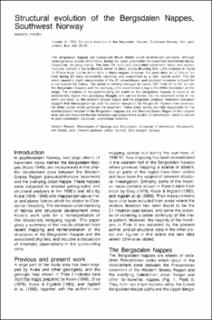Structural evolution of the Bergsdalen Nappes, Southwest Norway
Journal article

Åpne
Permanent lenke
https://hdl.handle.net/11250/2674119Utgivelsesdato
1993Metadata
Vis full innførselSamlinger
- Artikler [1064]
Sammendrag
The Bergsdalen nappes are Caledonian thrust sheets which experienced perva- sive, although heterogeneous ductile deformation during the upper green- schist to lowermost amphibolite-facies, Caledonian, thrusting history. The linear D1 fabric and associated assymetric meso- and microstructures indicate a top-to-the-ESE sense of shear during thrusting (D1). Little evidence is found for Precambrian ductile deformation in these nappes. However, the penetrative set of fabrics formed during D1 were consistently reworked and overprinted by a later, ductile event. This D2 event caused a slight retrogression of the D1 assemblages, and abundant evidence is found for a non-coaxial D2 history. The sense of vorticity changed by nearly 180\u00B0 from D1 to D2, so that the Bergsdalen Nappes and the overlying units experi- enced to a top-to-the-VNW transition at this stage. The influence of the post-thrusting D2 event on the Bergsdalen Nappe is found to be considerably higher than previously thought, and can be traced into the basement rocks to the north and west, i.e. the Western Gneiss Region and the Øygarden Complex. Kinematic indicators suggest that Hardangerfjorden and the eastern margin of the Bergen Arc System mark extensional shear zones which penetrate the base- ment. These shear zones are held responsible for the southeastward rotation of the Bergsdalen Nappes and the Western Gneiss Region in the mapped area, and are therefore the last recorded expression of the ductile D2 deformation, which is related to post-Caledonian, Devonian, extensional tectonics.
